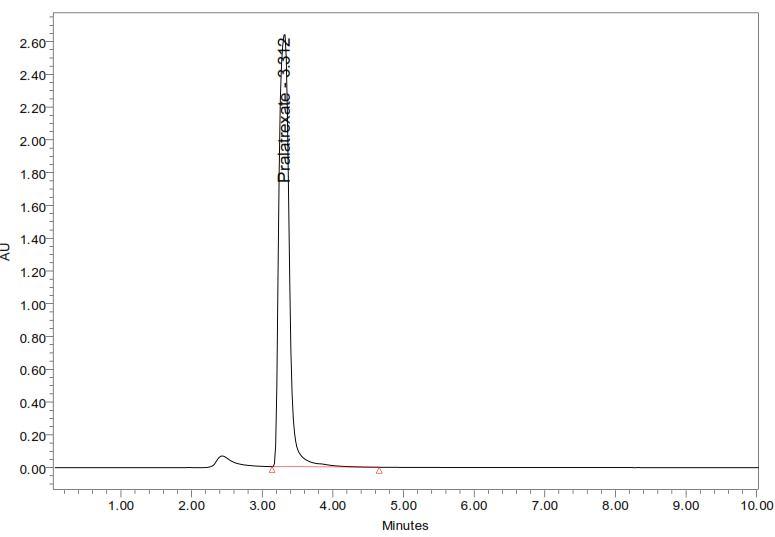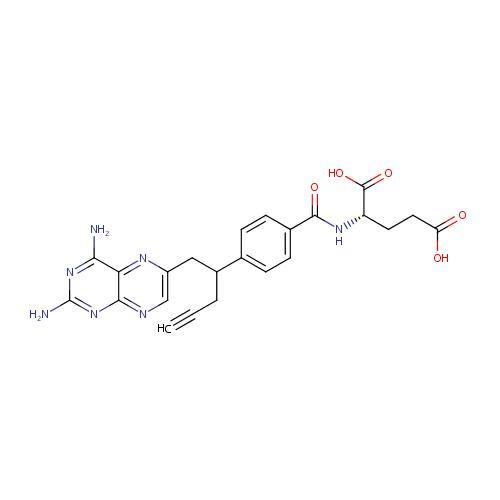

Estimation of Pralatrexate by Simple and Fast Reverse Phase High Performance Liquid Chromatographic Method
Syeda Kulsum1, Ayesha Naz2, Misbah Zareen3, Amatul Noor4
Professor, MRM College of Pharmacy
Associate Professor, MRM College of Pharmacy

Student, MRM College of Pharmacy
Abstract: A simple, specific, precise, accurate, and sensitive Reverse Phase High Performance Liquid Chromatographic method has been developed for the determination of Pralatrexate in both pure and pharmaceutical dosage forms. In this method Agilent (4.6×150mm) 5µ column in isocratic mode with mobile phase containing water: methanol (25:75% v/v) was selected. The effluents were monitored at 300 nm and flow rate was fixed as 1.4 ml / min. The retention time was 3.312 min. The linearity was in the range of 20 100 g / ml. This method was validated for linearity, precision, limit of detection, limit of quantification and accuracy. Statistical analysis proves that the method is precise, reproducible and selective for the estimation of the pralatrexate drug.
Keywords: RP HPLC, Pralatrexate, Validation.
I. INTRODUCTION
The cancer cells generally have an over expression of reduced folate carrier protein 1 (RTC 1) compared to normal somatic cells. This carrier protein allows the entrance of pralatrexate into the cell. Upon entering the cell, folypoly glutamate synthase FPGS catalyzes the poly glutamination of pralatrexate so that it is retained inside the cell. Once inside, pralatrexate competitively inhibits dihydrofolate reductase (DHFR) and thymidylate synthase.1, 2 Subsequent depletion of thymidine monophosphate (TMP) occurs so that the cancer cell is unable to synthesize DNA and RNA. As a result, the cancer cell cannot proliferate and is forced to undergo apoptosis. Pralatrexate is more effective against cells that are actively dividing.3, 4, and 5. No analytical methods that have been reported so far for the estimation of Pralatrexate by HPLC method. The objective of the work was to develop simple, accurate, precise and economic RP HPLC method with lesser run time to estimate the Pralatrexate in bulk and pharmaceutical dosage forms.
II. MATERIALS AND METHODS
The liquid chromatographic system consisted of following components. A Shimadzu HPLC model 2695, UV detector 2487 and Pump, variable wavelength PDA detector and Hamilton syringe (50 µL).
Chromatographic analysis was performed using empower software on an Agilent (4.6×150mm) 5µ column. The mobile phase consisting of water and methanol (25:75% v/v). The optimized chromatographic conditions are summarized in Table 1 and Pralatrexate structure is seen in figure 1.
A. Preparation of Pralatrexate Standard Preparation
10 mg of Pralatrexate was accurately weighed and transferred into a 10 ml clean dry volumetric flask and add about 2 ml of mobile phase which is used as a diluent and sonicate to dissolve it completely and make volume up to the mark with the diluent. Further pipette out 1ml from the above stock solution into a 10 ml volumetric flask and was diluted up to the mark with diluent. The solutions were injected using a 20µl fixed loop in to the chromatographic system at the flow rate of 1.4ml/min and the effluents were monitored at 300nm, chromatograms were recorded. The Pralatrexate was eluted at 3.312min as shown in Fig: 2 The method was extended for the determination of Pralatrexate in pharmaceutical dosage form.
ISSN: 2321 9653; IC Value: 45.98; SJ Impact Factor: 7.538

Volume 10 Issue IX Sep 2022 Available at www.ijraset.com
calculated. From that 10
add about 2ml of diluent and sonicate to dissolve it
diluent. Further pipette 10ml of the above solution into a 100ml

to
Fig.1:
concentration of the drug in tablet

solution was calculated by
validated as per the ICH guidelines.
Technology (IJRASET
ISSN: 2321 9653; IC Value: 45.98; SJ Impact Factor: 7.538

10 Issue IX Sep 2022 Available at www.ijraset.com
III. RESULTS AND DISCUSSION
The method optimized above was validated and chromatograms
it was found to be linear. The precision was measured in terms of repeatability and
various parameters6, 7 were obtained. The results obtained were within acceptable limits (Table 2). Thus the system meets suitable criteria. The calibration curve was obtained for a series of concentration in the range of 20 100
precision was determined by sufficient number of aliquots of a homogenous sample. The % RSD was found and lying within 2. This showed that the precision of the method was satisfactory. The accuracy of the method was inferred from precision and linearity studies of the standard. The % RSD was less than 2.0.
showed that the recoveries of pralatrexate by the proposed methods was satisfactory. Limit of detection (LOD)
Limit
quantification (LOQ) were determined by the proposed methods.
summarized in Table 3. The results of recovery studies obtained by the proposed method were evaluated and are given in Table 4. The assay results are mentioned in table 5.
results of validation
Table
Authors
Limit
Table
IV. ACKNOWLEDGEMENTS
Journal for
in Applied Science & Engineering Technology (IJRASET

ISSN: 2321 9653; IC Value: 45.98; SJ Impact Factor: 7.538 Volume 10 Issue IX Sep 2022 Available at www.ijraset.com
REFERENCES
[1] Allos Therapeutics Press Release. (Allos Therapeutics' Pralatrexate Demonstrates Anticancer Activity in Multiple Cancer Cell Lines). Eastern Daylight Time, 2009.
[2] Allos Therapeutics Press Release. (Allos Therapeutics' FOLOTYN(TM) First and only FDA Approved Therapy for Relapsed or Refractory Peripheral T cell Lymphoma). Allos Therapeutics, Inc. 2009.
[3] Chris H, Takimoto and Emiliano Calvo (Principles of Oncologic Pharmacotherapy). Psychiatric Times, 2005.
[4] Robert AN and Alfred HW. Pharmaceutical process validation. 3rd ed., New York, James Swarbrick, 2001
[5] Green J M. A practical guide to analytical method validation. Anal chem., News Feat, 1996.

